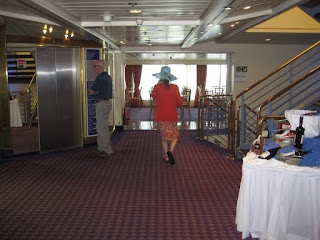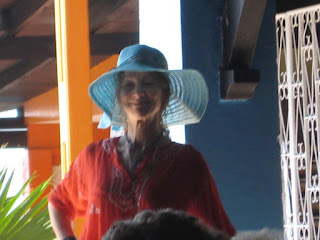In
the competitive world of ocean cruising there are big ships and there are
little ships. Our ship was supposedly a little ship. Friends who have done a
lot of ocean cruising said the Celestyal Crystal was one of the smallest ships
they’d been on. It had a capacity of one
thousand passengers but only carried a little over six hundred on our cruise.
That would be about five hundred and fifty over-capacity to my liking.
Cruising,
I think, is a lot like road-tripping. People either love it or can leave it…to
someone else. Perhaps it’s a cultural thing. Most of the folks we talked to
recently love the idea of sailing off into the horizon and visiting foreign
ports of call. They can rattle off a tally of exotic destinations and
fascinating harbors right out of some adventure novel. Their enthusiasm
reminded me of the river boat fanatics we met several years ago, on our own
European river cruises.
No
surprise then that the ocean cruise line industry has grown by leaps and
splashes. Worldwide, the industry has experienced an annual compound growth
rate of 6.55% from 1990 to the present. This growth has been driven in most
part by new builds, more local ports, more destinations and new
on-board/on-shore activities. Of course, they never mention the up-charges that
can match the airline industry one irritating point per point.
From
2015 to 2017, twenty-one new ships have been launched. Disney got into the game
several years ago and there’s even a new Titanic II (I kid you not!) now plying
the Seven seas. Most can hold from two thousand to four thousand passengers on
one cruise. I can’t imagine!
Recently
Sharon and I spent ten days onboard the Celestyal Crystal. It’s one of the
smaller cruise ships that ply the Caribbean waters during the winter months. In
the summer months, it returns to its native Greece and circles the islands
there.
We
left Montego Bay, Jamaica and circled the island of Cuba, stopping at several
cities including Havana, Santiago de Cuba, and Cienfuegos.
Our
friends had found this cruise/tour package and enlisted some thirty-nine of
their closest friends to come along. Most were from Palm Springs but others
came from as far away as Minnesota, Maine, Nevada and beyond.
I
used to think Sharon and I wouldn’t consider a cruise because of Sharon’s
issues with motion sickness. Now I realize another more subtle reason is my
distain for large crowds, the herd mentality among tour directors and pushy people
jostling for my early morning coffee. I’ve come realize the more sedate,
relaxed atmosphere of a European river cruise (Max. capacity 125) is more to my
liking.
Like
the airlines, cruise ships love to play the up-charge game. If it’s for sale,
they’ll find a way to wiggle even more cash out of it. I can’t complain too
much though. At least our ship had toilet seats in the cabin bathroom along
with toilet paper. That was a far cry from the ninety-nine percent of
lavatories in many of the Cuban sites we visited. We were warned to bring our
own paper and they meant it.
Despite
my alter-ego cowboy self, I don’t much fancy herding cattle. With a passenger
load that size, herding cats would have been a more apt description the the
crowd control and maneuver-ing that went on at every tourist stop.
The
crowds varied but most were in their sixties and seventies with a sizable number nudging even higher. They came in every size and shape and color; their
outfits that is. One woman in particular caught my eye. She wore a large blue
bonnet that ringed her face and reminded me of the blinders that draft animals
used to wear.
She
prowled the early morning breakfast area, darting in and out of the main
cafeteria, several eating areas, the aft-deck, the forward deck and then back
again. It was like she was casing the place so she could come back later and steal
a dirty plate or two. Then she disappeared and I got distracted by the pastry kiosk.
Santiago
de Cuba was our first stop. It’s the capitol of the island’s ‘Wild East’ and
it’s glittering cultural nerve center. We went to their African Cultural Center
and enjoyed native dances and songs. Fidel Castro plotted his revolution on
this eastern end of the island. After his first coup failed he went to Mexico
for two years then returned and hid in the mountains nearby to begin again.
We
spent two days in Havana. The capitol city of four million inhabitants is
bustling with antique cars, horse-drawn carriages, crumbling buildings and
fabulous architecture. The old city center, where we spent a lot of time,
comprises a mix of Baroque and neoclassical monuments and a homogeneous
ensemble of privates houses with arcades, balconies, wrought-iron gates, and
internal courtyards.
For
the most part, their classic cars are now taxies.
We
were taken to several of Earnest Hemmingway’s hideaways whether he really drank
there or not. One hotel in particular was his favorite when he was in town.
There are large photographs of him adorning the walls and for a couple of
pesos, they’ll even take you upstairs to see his room.
The
reconstructed plazas that now sport outdoor bars and restaurants and hordes of
kids circling.
The
back alleys and walkways took us past gutted-out buildings whose facades hid
decades of commerce and living before time and communism scratched away at
their livelihood and existence. The government, we were told, is trying to save
and restore as many of these wonderful buildings as their thin reclamation
budgets will allow.
Our
last stop was Cienfuegos. This ‘Pearl of the South’ is a 19th
century planned city and a UNESCO World Heritage site. It sits at the heart of
the country’s sugar cane, mango, tobacco, and coffee production area.
We
visited the home/gallery of world-famed artist Santiago Hermes Martinez and
watched a group of his art students perform a dance.
Then
we went to a school for challenged students whose art work was outstanding.
Back
in the fifties the harbor and Back
Bay of this quaint town was a welcoming haven for American mobsters who had big
plans for hotels and casinos before that rebel with a beard dashed their hopes
of creating a new Miami outside of Havana.
I
saw the lady in the blue bonnet again near the end of our tour.
Turns
out she was another group leader which explained her motherly instincts that
first morning I saw her hovering in the breakfast area. She seemed quite good
at herding, hustling, and controlling her group of fellow tourists.
I
must admit the aft-deck did provide me with a welcome respite from the cramped
quarters of our cabin and a chance to recharge my mind. I worked on my speech
for the Rosemount Writers Conference in March, touched-up ‘Club 210’ and outlined
a dozen or more blog treatments this cruise had generated.
In
the future, I’ll probably settle for more river cruises instead of ocean
roulette but the sunsets aren’t nearly as spectacular.





















































